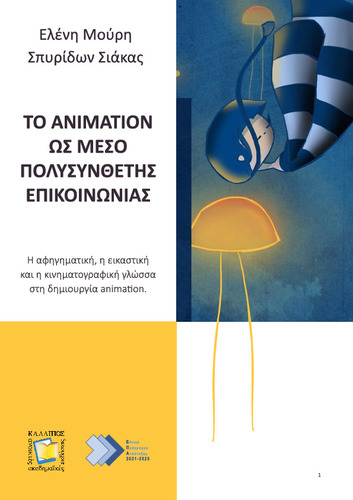| Title Details: | |
|
Animation as complexity communication |
|
| Other Titles: |
Narrative, visual and cinematic language in the creation of animation |
| Authors: |
Mouri, Eleni Siakas, Spyridon |
| Subject: | HUMANITIES AND ARTS > ARTS AND LETTERS > PHILOLOGY > LITERARY FORMS AND GENRES > PROSE > SCRIPTS > FILM SCRIPTS HUMANITIES AND ARTS > ARTS AND LETTERS > ARTS > ART STYLES > COMMERCIAL ART HUMANITIES AND ARTS > ARTS AND LETTERS > ARTS > ART THEORY > ARTISTIC CREATION HUMANITIES AND ARTS > ARTS AND LETTERS > ARTS > ART THEORY > ICONOGRAPHY HUMANITIES AND ARTS > ARTS AND LETTERS > ARTS > ARTISTS > FILM MAKERS HUMANITIES AND ARTS > ARTS AND LETTERS > ARTS > ARTISTS > GRAPHIC DESIGNERS HUMANITIES AND ARTS > ARTS AND LETTERS > VISUAL ARTS > GRAPHIC ARTS > GRAPHIC DESIGN HUMANITIES AND ARTS > ARTS AND LETTERS > PERFORMING ARTS > CINEMA > FILM MAKING |
| Keywords: |
Visual communication
Visual art Graphic Design 2D and 3D design 2D and 3D motion Illustration Animation Film script |
| Description: | |
| Abstract: |
In this book the way of thinking and research is developed, gradually in order for the essential stages regarding the animation films - animated spots to be comprehensible as these commute specific themes to a target group. The animated spots or the short animation films convey ideas and views through multiple channels of communication, such as the use of animation in relation with the visual art choices, the sizes of the shots, the camera movement, the sound, the rhythm and the montage. The chapters are constructed as a comprehensible guide to highlight the possibilities that the animation offers about the communication of complicated ideas to a specifically chosen target group. The method of script creation is written, thoroughly , starting from the research in the basic theme in order to commute the content. Thisprocedure leads the creators to the main idea of the content and finally to the writing of the script, according to the target group, to whom the animation film-animated spot is addressed.The use of film language and the visual art choices are thoroughly analysed as methods of visual communication. The following chapters are dedicated to the creation of the storyboard. They are focused on the animation storyboarding and especially on the narrative and informative animation through examples from students’ projects. In these examples, an analysis is conducted from the idea and the storyboard until the final film. The last two chapters are about the creation of the animatic and the production of file/bible from the storyboard. Every chapter ends with exercises. These exercises are steps which lead the students to the creation of the final project at the end of the semester, which is the organized material for the animation film and/or animated spot production.
|
| Linguistic Editors: |
Trivella, Lamprini |
| Graphic Editors: |
Papaioannou, Angeliki |
| Type: |
Undergraduate textbook |
| Creation Date: | 07-09-2023 |
| Item Details: | |
| ISBN |
978-618-228-089-8 |
| License: |
Attribution - NonCommercial - ShareAlike 4.0 International (CC BY-NC-SA 4.0) |
| DOI | http://dx.doi.org/10.57713/kallipos-322 |
| Handle | http://hdl.handle.net/11419/10508 |
| Bibliographic Reference: | Mouri, E., & Siakas, S. (2023). Animation as complexity communication [Undergraduate textbook]. Kallipos, Open Academic Editions. https://dx.doi.org/10.57713/kallipos-322 |
| Language: |
Greek |
| Consists of: |
1. Animation as a form of art 2. The first steps to create an animation film 3. The narration in fiction animation 4. The connection between Graphic Design and animation. Informative animation and motion graphic 5. Writing the script 6. Concept art in animation creation 7. The development of the film's narrative through the creation of storyboards 8. Choosing the size of the shots as parts of the narration 9. The position and the movement of the camera as part of the narration 10. Editing, tempo/rhythm and the transitions 11. From storyboard to animatic 12. Creating the folder of pre-production for an animation film |
| Number of pages |
342 |
| Publication Origin: |
Kallipos, Open Academic Editions |
| You can also view | |
| User comments | |
There are no published comments available! | |

